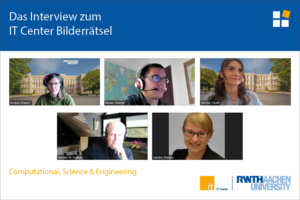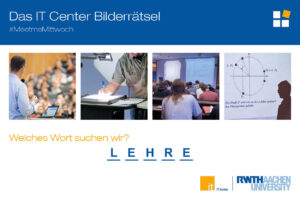#MeetMeWednesday: Our series “The IT Center Picture Puzzle” went into the third round and we were again looking for a word on our social media channels that stands for a department of the IT Center.
We were looking for five letters and the word “Lehre” (teaching) – did you guess it? In this blog post, we present not only the solution word, but also the corresponding interview with the Computational Science & Engineering (CSE) department. In this interview, you will learn more about the fields of activity and gain exciting insights into the diverse department of the IT Center.
Who is behind CSE and why is the CSE department at the IT Center essential?
CSE: CSE stands for Computational Science & Engineering. This includes all departments and groups that have teaching and training as their tasks at the IT Center. On the one hand, the IT Center is traditionally closely linked to a chair at RWTH – this is Chair I12 – Computer Science 12, which includes the teaching and research areas of high-performance computing, virtual reality and immersive visualization. Here, the head of the IT Center, Prof. Matthias Müller, and Torsten Kuhlen have the leadership.
Then again, the VR (Virtual Reality) group is in charge of various hardware for the simulation of virtual realities such as the AixCave or HMD (Head Mounted Displays) and specialized software developments for this purpose. These techniques make it possible to create artificial (simulated) environments in which the human senses are involved. For example, training scenarios for medical professionals are developed here.
The VIS (Visualization) group researches the visualization of data sets in order to generate an overview of complex data sets and data errors using two-dimensional representations.
On the other hand, the VR (Virtual Reality) group is in charge of various hardware for the simulation of virtual realities such as the AixCave or HMD (Head Mounted Displays) and specialized software developments for this purpose. These techniques make it possible to create artificial (simulated) environments in which the human senses are involved. For example, training scenarios for medical professionals are developed here.
The VIS (Visualization) group researches the visualization of data sets in order to generate an overview of complex data sets and data errors using two-dimensional representations.
Since the 1970s, the IT Center has been home to the MATSE (mathematical-technical software developers) vocational training center. In the lecture hall of the IT Center, the theoretical events of the study program Applied Mathematics and Computer Science (FH Aachen), which is linked to this vocational training, take place. The IT Center is one of the two leading training providers for MATSE at RWTH.
How many employees, how many teams and groups are there at CSE?
CSE: The CSE department consists of 4 groups:
- HPC – High Performance Computing – group leader: Dr. Christian Terboven
- VR – Virtual Reality – group leader: Andrea Bönsch
- VIS – Visualization – group leader: Dr.-Ing. Tim Gerrits
- MATSE – Group Management: Benno Wienke
The group HPC has 19 employees, 3 trainees and 10 student assistants; the group VR has 11 employees, 3 trainees and 10 student assistants and the group VIS 4 employees. The VR and VIS groups together have another 5 employees. The MATSE group has 11 employees, 6 trainees and 4 student assistants.
What are the main tasks of the CSE department and what makes the CSE department special?
CSE: Each of the groups in the CSE department is responsible for one aspect of teaching or training.
HPC has as its task specialized computing on fast computers (high performance computers). This includes dealing with special programming environments that enable the processing of huge amounts of data efficiently and quickly.
The VR group supervises projects that create an artificially recreated (virtual) reality on special technical devices such as AixCave and HMD. Here, large amounts of data have to be computed very quickly.
The VIS group takes care of the representation (visualization) of large amounts of data, such as those generated by many research projects at the RWTH. This allows a researcher to get an overview of the nature of his data and its correctness.
The HPC, VR and VIS groups support other researchers at RWTH – they visualize the results, enable new research aspects using virtual reality or increase the performance of very complex simulations using special programming models on the high performance computer.
In addition, the training of MATSE (mathematical-technical software developers) is one of the main tasks of the CSE department – MATSE are needed everywhere in teaching, research and administration at RWTH for software tasks. They complete their practical training in the CSE department and work on software development projects.
What are the current projects/developments? What does the future of CSE look like?
CSE: The HPC, VR and VIS groups are working together with other universities, such as TU Darmstadt, on the large-scale project NHR4CES (National High and High Performance Computing for Computational Engineering Science). This is a large field that includes many motivated projects from engineering and natural sciences (but also others) that involve larger computations, often simulations. This is already giving rise to many more research projects in the IT Center and the other universities, and will continue to do so in the future, with which employees can earn doctorates. Parallel to this, teaching at the RWTH for these groups or teaching in cooperation with the FH Aachen for the MATSE group is one of the cyclical tasks of the groups according to the curricula. This teaching is enriched by the latest findings through participation in the research projects.
Thank you very much for the interview!
We hope you have now gained a good impression of the activities and developments of the CSE department. Are you already curious about the next puzzle?
Responsible for the content of this article are Claudia Keverpütz and Arlinda Ujkani.






